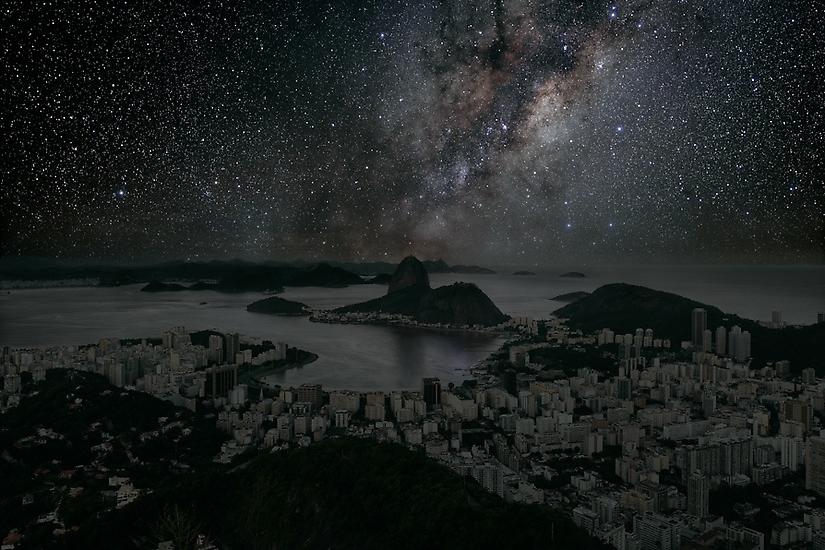

Light pollution and astronomy really don’t go hand in hand at all. Since a majority of the world’s population lives in built up areas, light pollution is becoming more and more of an issue, especially as the built up areas expand farther and farther out into the countryside. Light pollution may not be noticed quite so much by the younger generation, but those may remember what a truly bright, starry sky used to look like. And it is likely that, over the years, you’ve noticed a real change in how far development has pushed out from the central business district of your city/town are started to invade places that were once (mostly) uninhabitable.
Take Melbourne as an example, housing estates are popping up everywhere. Generally speaking, housing estates aren’t placed in already built up areas because there is no room, so city planners go out of the city and dump 20,000 homes on the outskirts. A decade or two later, the area has become saturated with people. So they move to the outskirts of this newly built up area to create more housing estates. And so the cycle continues.
The light pollution of a city as large as Melbourne can still be seen from 150km (93 miles) away, and it is clearly visible in a long exposure photo.
So with light pollution stretching out as far as it does, how do we deal with it?
I’m going to break this into two parts, that of visual observation and in a photographic sense.
With light pollution there are 4 main things we can do (some ideas are, obviously, much better than others):
- Just give up, throw in the towel and say that the skies are too polluted and that you want another hobby.
- Somehow manage to disrupt all the power in your city for a night so that the only lights working are battery operated and cars. Although there will still be some light produced from these sources, your skies will still be quite clear (editors note: we will not be held accountable if any of you run out and start attacking power plants).
- Head out to a location where the skies are darker. This doesn’t have to be too far either. Although, in the preceding paragraphs, I’ve mentioned that light pollution stretches out for about 150km in every direction, the sky starts to get noticeably clearer the moment you leave a city or town. In fact, some of the best skies that can be found are within about 120 km of Melbourne. In short, drive an hour or so away from your city in a direction that takes you away from other major light sources, and chances are, you’ll get some pretty good viewing.
- Another good way to somewhat beat light pollution is with the use of filters. One of the more common type of filter for general observing is called a “Light Pollution Filter.” The actual name for this type of filter is a UHC filter or Ultra High Contrast. It’s a broadband filter with narrowband subtraction. In simple terms, it lets through almost all of the light you want while blocking out the light pollution (Sodium and Mercury lines). Narrowband filters such as O-III and Si-II and H-a are also good for specific deep sky viewing.
Now onto photography: Moving away from the city lights is, by far, the best option. It allows you to photograph the entire sky and not just the individual objects that you happen to be able to see.
But this is not possible for many people, which is why, in astrophotography, filters are a must (especially with the narrowband filters). If you were to ask around, about 50% of people would say that UHC filters are good, while the other 50% say that they’re not that useful. However, you can never fully anticipate what conditions you will encounter, so when photographing in light polluted areas, they’re better to have than not.
Narrowband filters are amazing in astrophotography (and amazingly necessary). They allow you to take spectacular images of deep sky objects without having to worry about either light pollution from cities or the moon’s glow. The reason for this is that they only allow very specific wavelengths of light though. In the case of the O-III filter, it only lets the light from ionised oxygen in while blocking pretty much all other light. Because of the way that these work, some of the best images taken by amateur astrophotographers have come from heavily light polluted locations. Sadly however, this is beyond the reach of many aspiring photographers, as these types of setups don’t come cheap.
To Sum: Observing can be done in light polluted areas, it can be done in cities, and even without any filers at all. However (obviously), when observing, light pollution does limit what you can observe, so it may just be a matter of being selective about what you view on any given night.
If there is a full moon, don’t expect to be able to see much of any deep sky objects, a full moon can do far more damage than a city’s light pollution. Instead, just look at the moon or the planets, bright double stars (there are quite a few bright ones up there in the sky). If you have a chance to go out for a night away from a city without the moon lighting up the sky, take advantage of it, remember you don’t have to travel too far to get some amazing views of the sky.
Also remember that filters are an aid, they aren’t the be all end all. Using a UHC filter near a city will make the object look at a little better but just keep in mind… NOTHING beats a darker sky 🙂